The pet food industry's dirty secret: Ingredient splitting, "real" meat, all-natural, and a ban on by-products
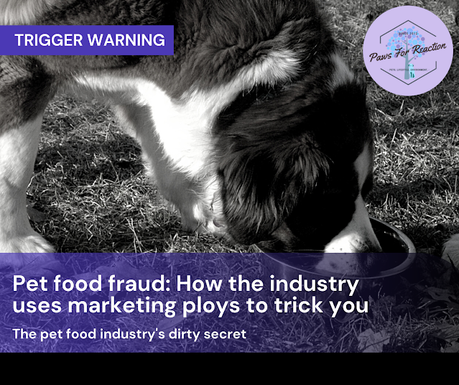
Do you think the concept of fake news is a recent thing? The retail pet food industry has been serving up its own brand of fake news for more than a decade. Today's pet owners are savvy and have a hunger for knowledge; much of the knowledge they seek is available at their fingertips. The tip of their paws, if you will. But like an all-caps tweet typed by Donald Trump on the toilet at 2:00 AM, most information dished by retail pet food companies will be found false once it's fact-checked. Much of the information is based on human diet trends that are influencing the industry. While conceptual and antidotal information is pleasing to hear and easy to digest- and science is confusing and questioning- it's important to remember the fundamental rule of retail: you are being marketed to.
I experienced it recently when an acquaintance who is not only highly intelligent but an excellent pet owner told me she doesn't feed veterinary pet food because it has 'so much crap in it.' I've said for years that ignorance isn't necessarily a bad thing- it's simply a lack of knowledge. I forget how fortunate I am to have nearly a decade of combined experience in the pet food industry and the veterinary industry. I've worked at a pet store, as an online influencer in the pet food and supply industry, and have over 6 years in veterinary medicine. I've even presented about nutrition to veterinary teams and worked as a nutrition advisory in a veterinary clinic. I know how the pet food label is structured and I'm well versed in pet food fraud.

Veterinary diets versus retail diets
My dog is at an advantage when it comes to her diet. If I feed her the right diet I can provide her with complete and balanced nutrition every time I fill her bowl. She's not going to binge eat mac n' cheese or eat an entire medium pizza in one sitting. Veterinary diets have been formulated by veterinarians and veterinary nutritionists. Veterinary diets can be therapeutic, using ingredients that help manage illnesses not allowed on the retail market. They can use higher therapeutic levels of specific supplements than the retail market allows. They go through dietary feeding trials. If your pet gets sick and must be changed to a therapeutic veterinary diet, these companies have teams of veterinarians to devise a nutritional treatment plan. They assist your pet's doctor and help monitor your pet's condition over time. Veterinary diets don't succumb to dietary trends to sell more bags. It's not about the bags sold- it's about the pets saved.
Human diet trends influencing the pet food market
I'm going to list some of the human food trends that are influencing how retail pet food companies are changing their marketing strategies to capitalize on the market. I'm not saying these trends don't meet human dietary needs. But as you know, the physiology of a human is very different from a dog or cat.
Whole foods/holistic: Great for human consumption. While feeding whole foods to your pet isn't dangerous, it also doesn't aid in providing balanced nutrition. Since we know we can provide pets with balanced nutrition, why wouldn't we? Whole foods on labels are also very misleading. Nutrients are greater than ingredients.
Carb free/gluten and grain-free: Sure, maybe you can dump the carbs and ditch the weight, but grain-free has no validity in the pet food industry.
Non-GMO: I have nothing against non-GMO food. In fact, I too shop non-GMO. But it should not be the first item on the itinerary when selecting my pet's food.
Paleo diet: I feel as though this diet helped inspire the dangerous raw food movement in pet food.
Vegetarian/vegan diets: I love these diets for humans, mainly because of their smaller carbon footprint. But this type of diet can be very dangerous for most dogs and cats.
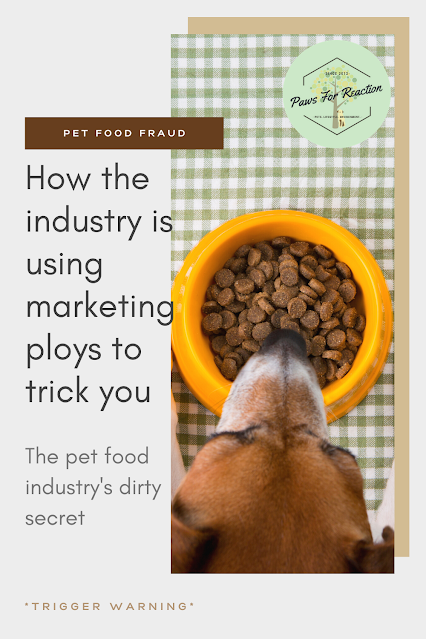
How the retail pet food industry is manipulating through marketing
Let's get to the meat and potatoes of pet food fraud. I first became interested in pet food fraud when Blue Buffalo dumped tons of dollars into a marketing campaign against by-products. Soon after, Purina launched a lawsuit against Blue Buffalo on the grounds of false advertising when it came to their pet food claims, stating they tested Blue Buffalo diets and found traces of by-products. The lawsuit may have settled in two years, but the problems in the industry continued. Certain healthy ingredients have suffered a dietary moratorium in the pet food industry not because of science, but because of advertising.
Trigger warning: It's time to tackle pet food's most hated ingredients and de-bunk popular pet food trends. I'll answer the following questions: How is the retail pet food industry manipulating its labels? How are they using marketing ploys to sell misinformation? What banned ingredients are bad and what aren't? Are certain ingredients more allergenic? Are certain diet trends healthy or dangerous?
Ingredient splitting: Despite years of marketing techniques and conversations with our pet expert friend Brenda, the order of the ingredients is not the most important factor in selecting your pet’s food. This is one of the most widely believed pet food myths. Items on the ingredients list are ordered based on their weight- heaviest to lightest. What most folks are unaware of, is a trick called ingredient splitting. This is a trick most commonly used with carbohydrates. Different carbs like corn, rice, barley, wheat, and oatmeal, are listed separately in different forms of the same carbohydrate, such as 'ground wheat' and 'wheat flour', so these individual carbs appear lower in the ingredient list. Doing so makes it appear as if carbohydrates are not the first ingredient and that the food is less carb-heavy. Carbs are commonly broken down like this:
Corn: corn gluten meal, cornflour, and whole ground corn
Rice: whole rice, white rice, brown rice, rice flour, and rice bran
Potatoes: dried potatoes, potato starch, potato protein, and potato flour
If listed together as just wheat instead of being broken up into parts, the wheat may appear higher than meat on the ingredient list. Since the marketing ploy of 'meat first' has been an important one in the retail market, this is than ideal. Below are some examples from real retail pet food ingredient lists showing ingredient splitting.
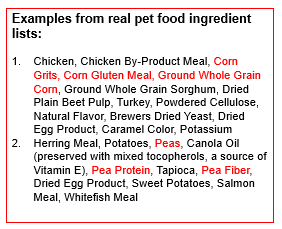
Natural or holistic diets: Whole foods, all-natural, natural ingredients. Sounds farm-fresh and super healthy, right? The AAFCO definition of ‘natural’ is any plant, animal, or mined source. The term natural has no association with the quality of the ingredient. In fact, nutrients are far more important than ingredients when it comes to your pet's food. Your dog's balanced nutrition does not require a certain amount of blueberries in a daily serving- but it does require a certain amount of taurine. Nutrients far exceed importance, especially since you may see 'blueberry' on the ingredient list and assume there is a cup of blueberries in the food, when really there may be only four blueberries added. By adding those four blueberries they can add the word 'blueberry' to the ingredient list, put a photo of blueberries on the front of the bag, preying on your desire to feed your pet the healthiest diet possible. Congratulations, you've just been marketed to!
Meat vs meal: Meat first is the pet food marketing ploy that won't let go. Meal gets a bad rep, mostly because folks don't know what it means and find it easier to believe pet food advertising than do real research. Meal is real meat with the fat and water removed. When you see chicken meal, that is real chicken without the water weight and fat. Meat first or ‘real meat’ diets contain more moisture (water) than meal diets. Since the ingredients on the pet food label are listed by weight, meal contains more nutrition because the added weight of water and fat have been removed. It's also important to note that 'whole chicken breast' is more pleasing for us to see on the label because we know what that looks like, but 'meal' is something we are not familiar with. The truth about whole chicken breast in pet food: the chicken is mechanically deboned and turned into white slime. Yum!By-products: By far one of the most hated ingredients in pet food, by-products have been vilified as disgusting and dangerous. When properly processed by-products are full of essential and healthy nutrients like protein, fat, vitamins, and minerals. They are healthy organ meats- heart, lungs, muscle, and liver- rich in nutrition. They are just as healthy as skeletal meats but are less desirable for consumption by western culture. They are not feet, beaks, bones, or hair. Many pet owners will insist by-products are bad and then give their dog a pig's ear, rawhide stick, or deer antler. Those are by-products! Since humans typically only consume 60% of a chicken, feeding by-products to our pets is sustainable. By-products are nutritious and not dangerous. Don't believe the fake news.

Raw diets: While well-processed by-products aren't dangerous, raw diets are. Raw diets are not nutritionally balanced and can be unsafe for both the pets and the owners. Raw meat or poultry may become contaminated with harmful microorganisms and may contain pathogenic bacteria such as Listeria, Salmonella, Escherichia coli, and Echinococcus. The spread of these can become a public health concern. Raw eggs can also contain harmful bacteria. Preparing raw meals can be harmful to the family, and the dangerous organisms can be transmitted through the pet`s feces, adding another element of risk. Many pet owners who feed raw food believe that raw bones are less likely to splinter. But raw bones can still splinter and have jagged or sharp parts that can injure a cat or dog. Raw bones can also cause constipation, gastroenteritis, intestinal obstructions, and GI perforation.
But my dog and cat are descendants of wild animals, and should be fed that way, right? Wrong. Your companion animal's bloodlines have been subject to a history of domestication. They have evolved to become domesticated animals and so has their gastrointestinal tract. Your pug is the farthest thing from a wolf. These raw, “wild animal” diets exist because they are trendy, but the truth is wild wolves and wild cats typically only live to be 2-3 years old. Wouldn't you rather your pug live to be sixteen? Most important of all is the lack of facts behind the feeding. There is no scientific evidence to support raw diets as being beneficial, and until they have any veterinary validity these diets are not worth the risk.
Homemade diets: Unless prescribed by a veterinarian with a strict recipe and nutritional supplements, homemade meals are not a balanced diet. If you have a laboratory and a team of veterinary nutritionists in your basement, then go for it. If not, only switch to a homemade diet under the advisement of your veterinarian.
Grain-free: Potentially the most dangerous diet of all, grain-free pet foods have piggybacked off of the carb-free human diet trends. There has also been misinformation around pet food allergies suggesting that grains are more likely to trigger adverse food reactions. Grains became a hot topic when the FDA released the results of a study linking grain-free and novelty retail diets to dilated cardiomyopathy, deadly heart disease, in dogs. Since then, most veterinary teams have taken a strong stance against grain-free diets until more studies have been completed.
Some pet owners think grains are indigestible. Once again, this is only true when they are not properly processed. When the indigestible outer husks have been removed from grains like wheat, rice, rye, oats, and millet they are an excellent source of energy and help provide complete, balanced nutrition for your pet. They are an excellent source of magnesium, iron, complex carbohydrates, and fiber. They are also rich in protein and essential amino acids. Avoid grain-free diets!
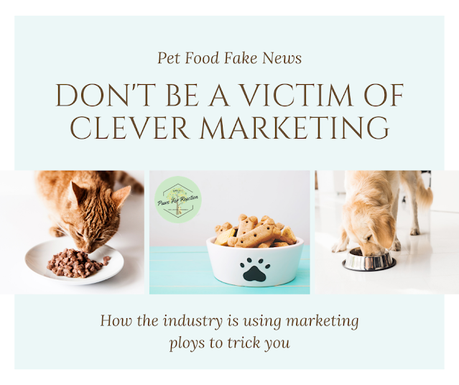
Gluten: Just because you're gluten-free doesn't mean your pet will also benefit from a gluten-free diet. Wheat gluten is one of the most digestible sources of protein for cats and dogs. It contains as much as 80% protein and approximately 99% is digested when it is part of their diet. The allergy to gluten known as celiac disease is a genetically transmitted autoimmune disorder in human beings. There are no reported cases in cats and dogs.
Brewer's rice: Brewer’s rice is small fragments of rice kernels that have been separated from the larger kernels of milled rice. This type of rice was traditionally used for brewing alcohol and is where the name ‘brewer’s rice’ originated from. The fragments of rice are not aesthetically pleasing to us humans. The perfect kernels of rice are used for human consumption and the broken kernels go to pet food. They aren't dangerous or lacking in nutrition compared to whole rice kernels.
Corn: Corn's biggest battle against fake news is that marketing has led pet owners to believe it is not digestible. This is false. Corn has a fibrous hull that holds its kernel form. When the kernel is broken by grinding, the germ (fat), starch (carbohydrate), and gluten (protein) are accessible and readily digestible. It's also widely believed that corn is a cheap filler, however, fillers have no nutritional value. Corn provides important nutritional value including essential fatty acids, vitamins, antioxidants, fiber, and minerals that are important in a pet’s diet.
Some pet owners also believe the incidence of food allergy to corn is high. Studies on food allergies in pets suggest that corn is equivalent or less allergenic than other proteins such as beef. In act, food allergy is diagnosed in less than 1% of all dermatological (skin) conditions in pets.
Vegan: Vegetarian and vegan diets are NOT recommended unless specifically prescribed by a veterinarian. Even in those cases, it is extremely rare to prescribe a vegetarian diet to a dog, and cats, being obligate carnivores, are almost never prescribed a vegetable-only diet. These are lifestyle diets for humans and are not healthy for the majority of pets. They can be extremely harmful.
Allergen ingredients: Certain ingredients like corn, grains, and chicken are not more of an allergen than other ingredients. They may appear to be by pet owners only because they are more commonly used in pet food.
Much of this is easy to discover if you ask the experts: veterinarians and veterinary nutritionists. Call the customer service number on your bad of pet food and see what tough questions they can answer. Don't dine on fake news and feed on pet food fraud. It does more harm than good- to you and your furry family members.
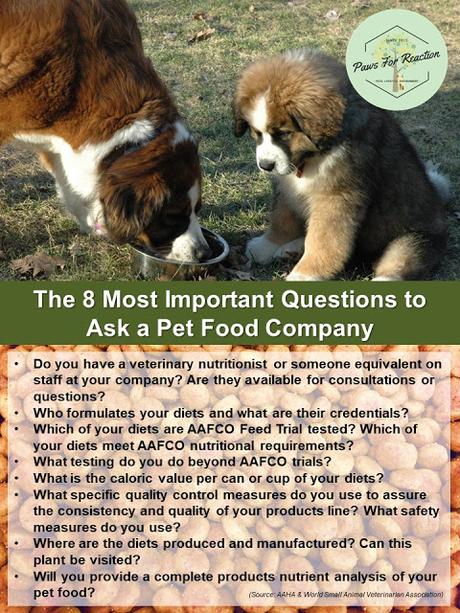
Give me a high paw and follow Paws For Reaction on PinterestLike Paws for Reaction on FacebookFollow @PawsForReaction on TwitterFollow my blog and subscribe in the sidebar >>
